Colored Pencil Blogger – A Video Blog Post!
This week, I have a video blog for you. It’s full of art inspiration, especially if you want to fall in love with colored pencils.
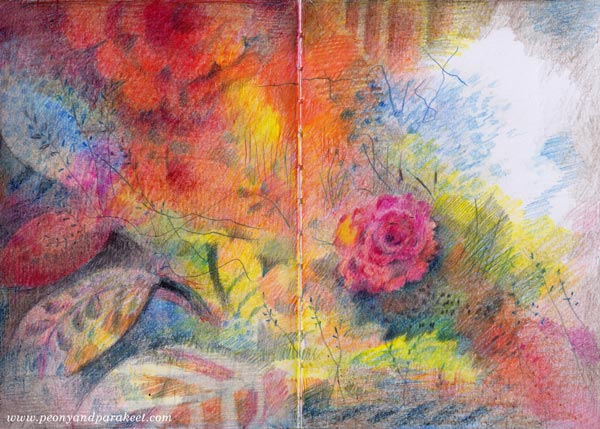
Stories and Inspiration – Watch the Video!
I decided that I have blogged about colored pencils so much that I can call myself a colored pencil blogger!
The video is longer than what I usually record. Is a 30-minute video too much? Tell me what you think!
Links to the Related Blog Posts
Posts about the colored pencil projects shown in the video:
- Coloring Page
- Angel
- Butterflies Journal Spread
- Hearts and Flowers Journal Spread
- Frozen Heart Journal Spread
- Drawing that I showed just quickly
- Previous video project
Posts about the paintings shown in the video:
Extra Post In Memory of Queen Elizabeth

When I was a child, I wanted to be the Queen of England. It was the greatest thing I knew. We lived modestly in a small Finnish town near the Russian border. On Sundays, when we got a thick newspaper and bought a women’s magazine from the local kiosk, we talked about royals in Europe. The greatest of all was Queen Elizabeth, of course. I admired her so much that I got a flower bench under my bedroom window and roses called Queen Elizabeth planted on it.
Queen Elizabeth was my queen back then and still has been. She has been our queen for so long that she has seen more than most of us. With her, a time period that a single human can comprehend and remember vividly now goes away.
We, Finnish people, remember the queen’s visit to Finland in 1976. When my parents saw our politicians taking her to a forest in a walking suit, they were upset and ashamed. I remember my mother sitting on the sofa horrified and even a child understood that our love for forests could have been presented in a more sophisticated manner. But we didn’t get any headlines where the queen would complain about her circumstances, and in fact, we haven’t got much of those during all these years.
So here’s to Queen Elizabeth one more time. She inspired me to dream about jewels and kennels, courts and stables, tartans and silk, and because of her, I looked at forests like they were palaces. It made life so much better then, and it still carries me now when I am an artist.
How Your Personal Story is Related to Your Art
This week, I share how my newest painting was born. At the same time, I talk about how the artist’s personal story affects the outcome.
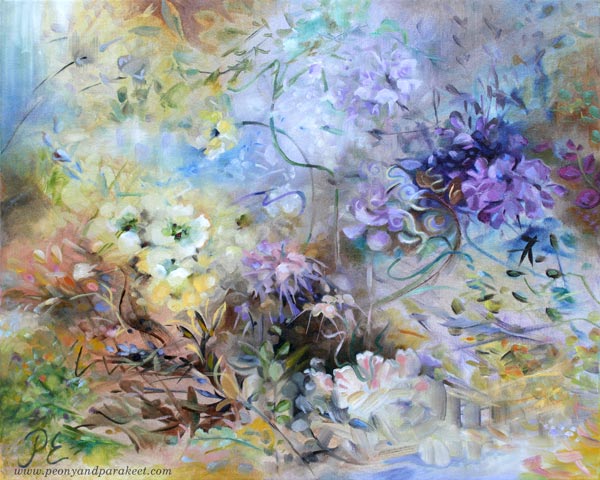
My paintings usually reflect the current season. But now, when there’s a fall in Finland, something springy appeared on my canvas. I call this one “The Spring of Dreams.”
Observing a Flower – Engineer’s and Romantic’s Approaches
Last spring was beautiful. The apple and cherry trees were blossoming.
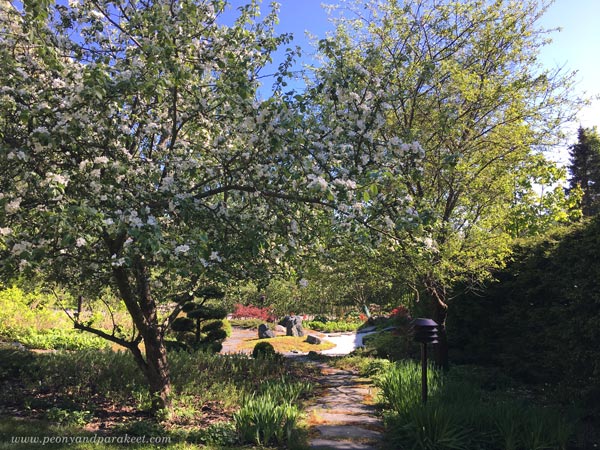
And with the early summer came wonderful irises.
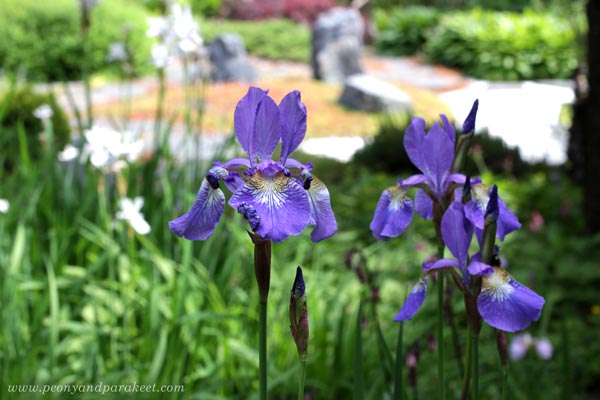
I often take photos in the garden and examine the plants. As a former engineer, I try to see how they are constructed. Not how the petals are attached and such, but how the light constructs the flower, adding its own brushmark to it. As a romantic, I try to see a face of a flower. I look at it like it would be an animal or a human – like it has a name and a history. I am not searching for its eyes but trying to sense its needs and dreams.
This way, I don’t need to copy photos but can paint freely and intuitively. Then when random shapes begin to look like a lighted plant, I try to give it what it wants, even if it’s often a species that doesn’t even exist.
The Fight Between Too Stiff and Too Messy
However, the painting process is not always as straightforward as it sounds. Often the engineer adds something stiff, and the romantic wipes it off. Then the romantic makes a mess, and the engineer tries to clean it.
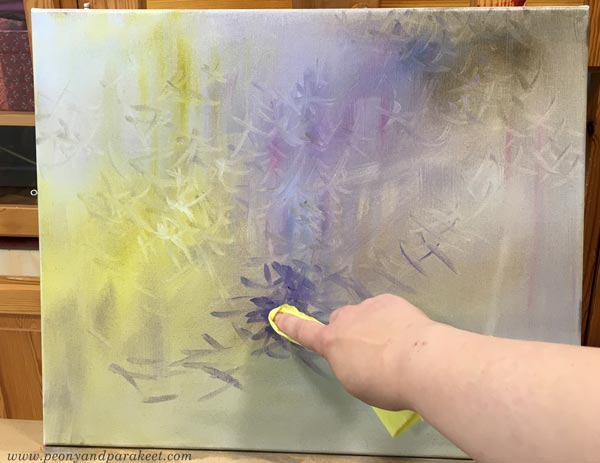
The engineer in me likes to build things with a brush: “There’s a chair, look!”
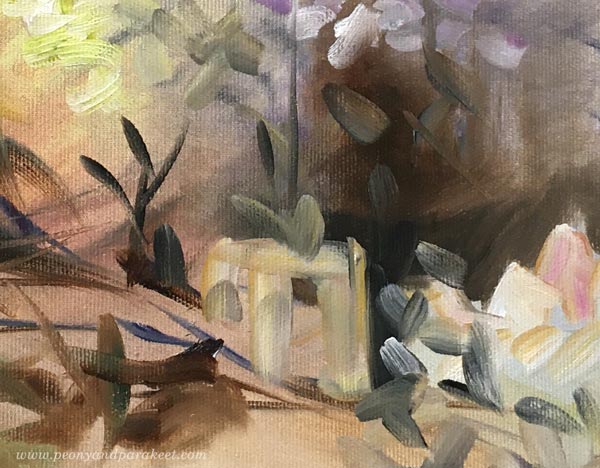
The romantic in me likes leaves and swirls more.
Artistic Direction and Setting Guidelines
To stop the fights, I gave an artistic direction that set challenges for both of them: “We will be making a dreamy floral that has purple. The painting should fit a modern, feminine home that has some rustic elements as well.” Both the engineer and the romantic understand had a common understanding of style when picturing a space where the painting should fit. When I use this method, I choose a location in my home or a picture in an interior design book, or a photo found on Instagram.

When I was studying industrial design, these kinds of simple and concrete guidelines were called design drivers. Design drivers are different from design principles. Design principles are general guidelines to make your image more expressive and aesthetic. Design drivers are project-based and loosely define the outcome.
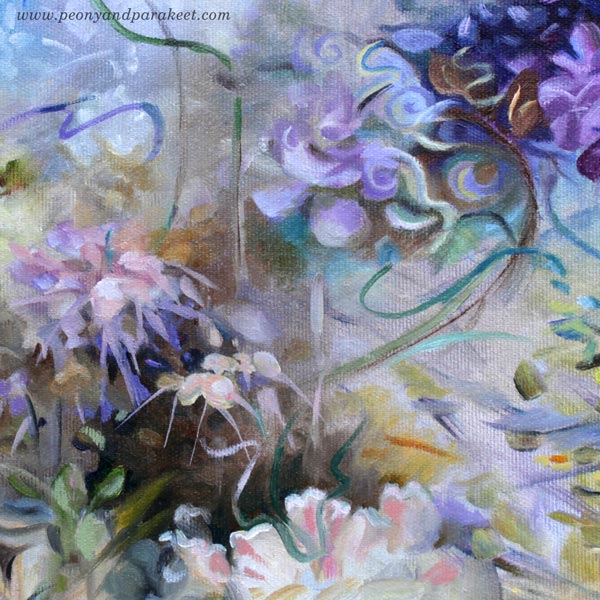
Design drivers prevent me from painting this and that, but I try to make them so general that I can get creative and freely express myself. For example, the requirement to use purple in a painting is not a big limitation.
Personal Story and Art Projects
Behind design drivers, there’s a more general foundation, an artistic vision. My paintings always lean toward the past and have a historical feel. As an artist, I want to combine the past and the present in an uplifting way, creating a fantasy of immortality for the interior space. Because I lost both of my parents at a young age, I never thought I would live old. This way, my artistic vision, and personal story are connected.

I claim that art-making has many layers. It’s not only about the process, techniques, or assignment. The artistic vision and the personal story matter as well. You always have a chance to bring them in, whether you are painting or drawing. For example, if a course sets the starting point, the creative challenge is how to include your artistic vision and story in the projects. This time, rather than listing things you love, go deeper and think about your struggles. How do they define what you want to achieve in art?
Draw a Coloring Page and Color It Creatively!
This week, we draw a coloring page and color it creatively.

Inspiration from an Artist Friend Eeva Nikunen
This blog post is inspired by my artist friend Eeva Nikunen. She is a master at drawing coloring pages. She has many self-published books, and just recently, she drew the Alice in Wonderland coloring book for a famous British company Colouring Heaven. I especially love Eeva’s illustrations of men, and her drawing skills are superior, much further than mine. Of the two of us, she is more of an illustrator while I am a painter, but we both alternate with drawing and painting.
Inspiration from Historical Styles
The Victorian era inspires Eeva, and I love it too. In 2020, I illustrated a book called Fairy Experiments for Thinkers and Tinkerers. It had over 60 Victorian-style line drawings and one simple coloring page as well. I have used a similar drawing style in the classes Animal Inkdom and Magical Inkdom.
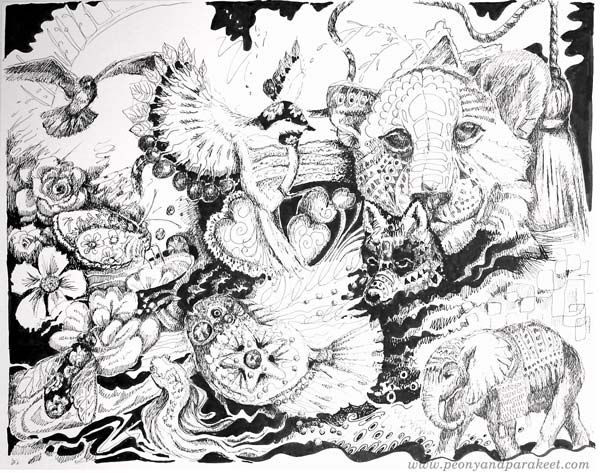
I also like Art Nouveau and Alphonse Mucha‘s illustrations. See this old blog post from 2015 where I draw in Art Nouveau style!
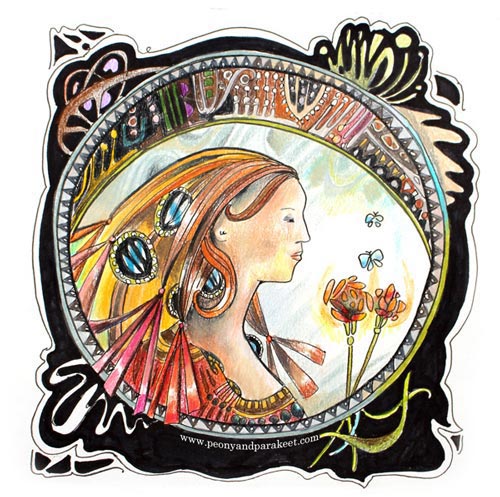
The blog post has a short drawing video too.
Art Nouveau has inspired me to create a set of coloring pages for the e-book Coloring Freely. Here are some samples of them.

Let’s Draw a Coloring Page!
There are great programs for drawing coloring pages like ProCreate and Adobe Illustrator. I like these programs, but I like to keep drawing with pens and pencils too. So let’s look at how to draw a coloring page by hand!
I started with a pencil, and the focus was first on the pose. When I had a rough idea of a woman romantically entering a scenery, I drew over the pencil lines with a black drawing pen. I like to use ink pens because I draw better when I can’t erase the lines. It makes me concentrate more, and my hand becomes steadier.
The sketch for the pose is number 1 in the photo. I think many of you would just throw it in the trash and think that the project is a disaster, but the secret is to keep going by tracing the sketch to another paper.
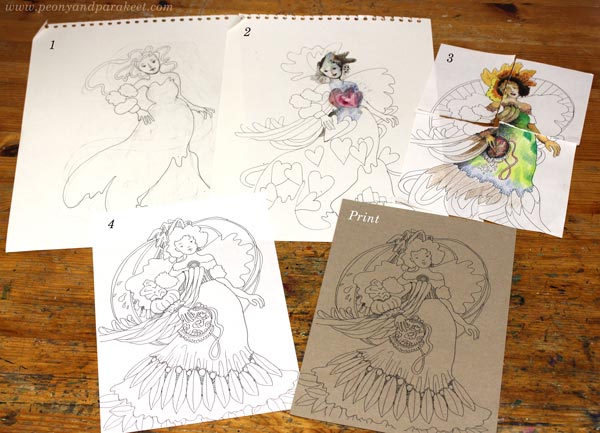
When tracing the old lines, you will get more ideas and new energy for adjusting the drawing. My second sketch had more elements, and I also started thinking about the facial expression of the character. When I ran out of ideas, I just drew hearts. Then I colored the sketch a bit to think about what the general idea of the image could be.
I like to develop ideas by drawing and coloring, not by thinking only. Many say they have images in their head, but mine are often too vague or too traditional. Drawing makes me more inventive and detailed. So, in the third sketch, the hearts were gone, and the lady had a bag, a leaf skirt, and a circle behind her. As you can see from the picture above, I threw the sketch away, but then when I thought about the blog post, I dug it out from the bin for the photo!
Here’s the third sketch without colors and the final version that I drew after coloring the third one for some time.
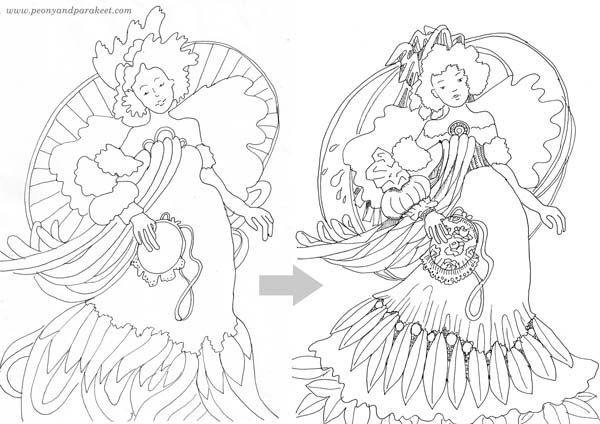
The final drawing is about saying goodbye to summer and hello to fall. The bag symbolizes summer and the circle became a giant pumpkin. If you compare my lines between the sketches, they become more delicate and detailed towards the end. The first sketch is a clumsy thing, but by redrawing the lady several times, I was able to make the design more flowing. Straight lines became curvier and curves got more notches, making the shapes more interesting. By leaving some of the elements visible only partly, the image looks more coherent and less floating.
Choosing Paper for Drawing and Coloring
The thin and smooth marker paper makes tracing easy. I got to know it when I was studying as an industrial designer. Art supply stores sell it. For coloring, I prefer thicker paper, so I scanned the image and printed it on a brown drawing paper.

Unbleached paper allows me to color a bit more carelessly and playing with pastels and whites is more fun.
Creative Coloring
An inspiring coloring page is not too detailed. I like pages that have some detailed elements, like the bag in mine, but that also have plenty of space for additional ideas. Then the coloring page can be treated as a foundation for creative coloring. For example, my page has pretty empty hem, and I can have fun by coloring freely – creating color changes and motifs that make the design more rich and stylish.
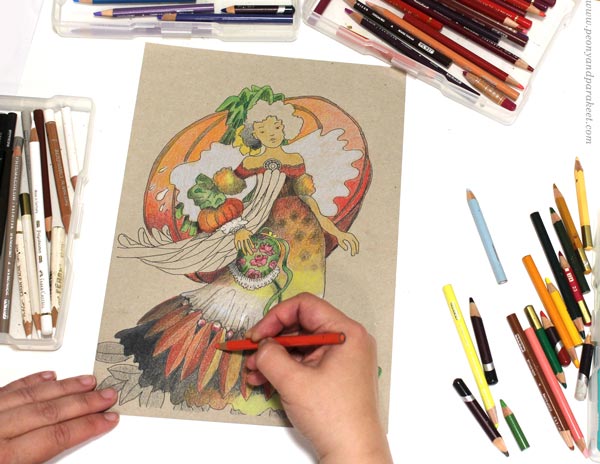
I also like to color over the lines so that coloring extends the original design.
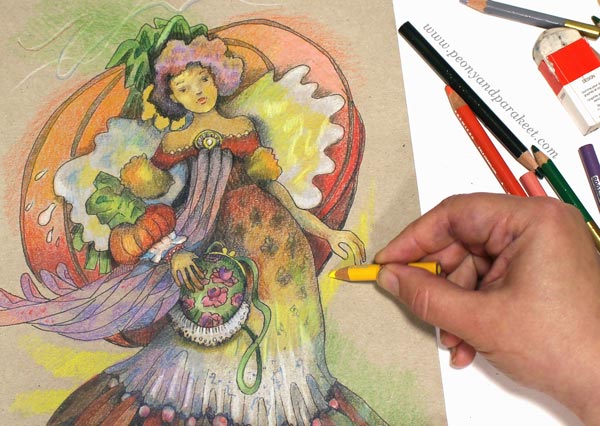
Compare the coloring page and the colored version below to see the additions made with colored pencils only!
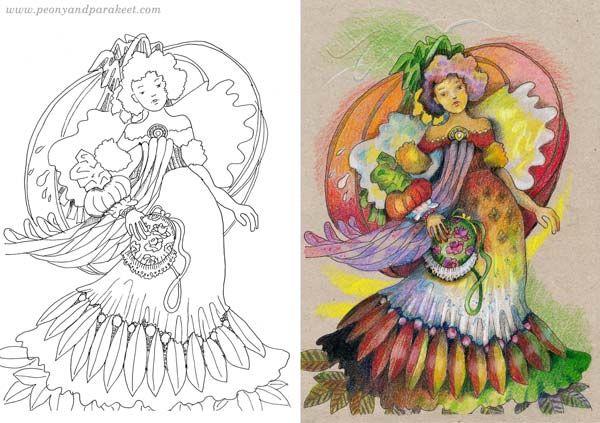
With colors, you can also change the style of the drawing. I think mine looks quite Alphonse Mucha without colors, but after coloring, less so. I like coloring shadows and making the design less flat than what Art Nouveau had.
The Intuitive Part of Intentional Art
After finishing a drawing that was born pretty intentionally, I like to ponder what had initiated it. I found this photo on my phone, taken a couple of days ago. The two-colored leaves looked so beautiful and bittersweet to me that I had snapped a picture of them.

I am sad that summer is over but also acknowledge that summers and falls are not separate. One carries the other. It’s not fall’s fault that the summer is gone, and the present that the summer gave is dear to her.
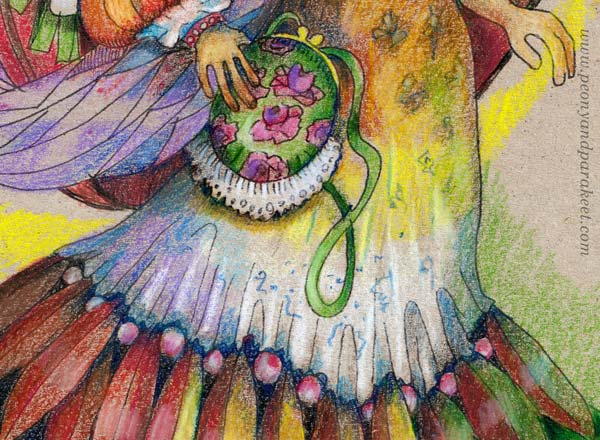
I hope this post inspires you to draw a coloring page through multiple sketches and then creatively color it!